Explore the moves:
The Hundred ⋅ Roll-Up ⋅ Coordination ⋅ Swimming ⋅ Thigh Stretch
If you’re into cycling, swimming, running, or any other endurance activity, there’s a good chance you have some aches and pains to show for it: a trick knee here, a stiff shoulder there, with an occasional tweaky ankle thrown into the mix.
Most of us are inclined to treat these problems symptomatically, with wraps and massage and ice. Good as those methods are, they often miss the root of the problem, because repetitive-use injuries often stem from imbalances in your torso muscles.
“The muscles in your chest, abdomen, and back are your foundation,” says classical Pilates instructor and competitive powerlifter Sonja Herbert, founder of Black Girl Pilates. “You can’t build anything on a weak foundation.”
In a single workout, a cyclist might perform a whopping 8,000 pedal strokes, a swimmer might windmill her arms a thousand times, and a runner might take 6,000 steps.
When you’re in prime condition, high-dose repetitive movement is no big deal. But if your foundational muscles are weak, or unable to activate or coordinate with other muscles when needed, it’s like driving on a wobbly wheel: Sooner or later, you’ll be in need of serious repairs.
“Pilates connects your mind to those muscles,” says Herbert. The popular training methodology uses low-impact exercises originating from the core to emphasize postural alignment, dynamic stretching, and powerful breathing. Moves often involve twists, rotations, isometric holds, pulses, and body-weight lifts, which can be performed on a mat or with equipment.
Pilates also helps train your central muscles to engage and relax. With these skills, repetitive movement takes less of a toll — technique improves, endurance increases, and injuries abate.
To build a foundation strong enough to support your loftiest goals — in the water, on the road, or in the saddle — try this mat Pilates workout.
The Hundred
Strengthens your abdominals and connects your breath to movement.
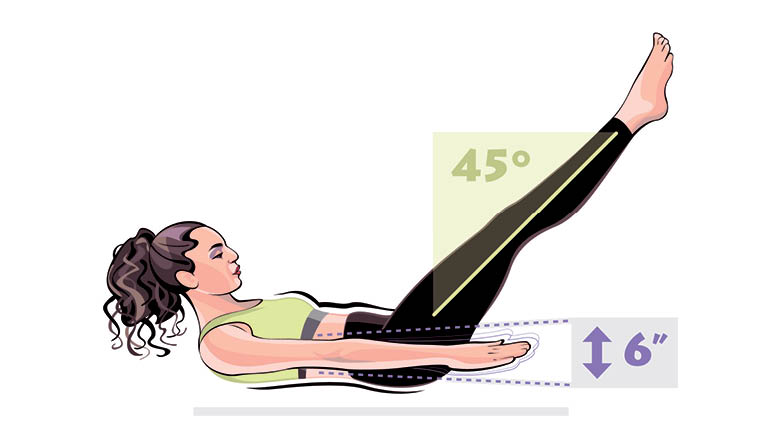
Repeat for five to 10 full breaths, or 50 to 100 pulses. Work up to completing the entire series without resting.
Full Instructions
- Lie on your back, arms by your sides, and draw your knees to your chest.
- Extend your legs about 45 degrees upward and lift your arms about 6 inches from the floor, palms down; engage your core to raise your head and shoulders off the floor.
- Keeping your body still and your arms straight, gaze at your navel as you pulse your arms up and down about 6 inches.
- As you pulse your arms, slowly inhale through your nose on a five-count of pulses, counting each time your arms go down, then exhale through your nose on another five-count.
- Repeat for five to 10 full breaths, or 50 to 100 pulses. Work up to completing the entire series without resting.
Make it easier: If it is difficult to keep your legs raised and fully extended, bend your knees so they are stacked over your pelvis and your shins are parallel to the floor. Or place your feet on the mat.
Roll-Up
Stretches your spine and hamstrings.
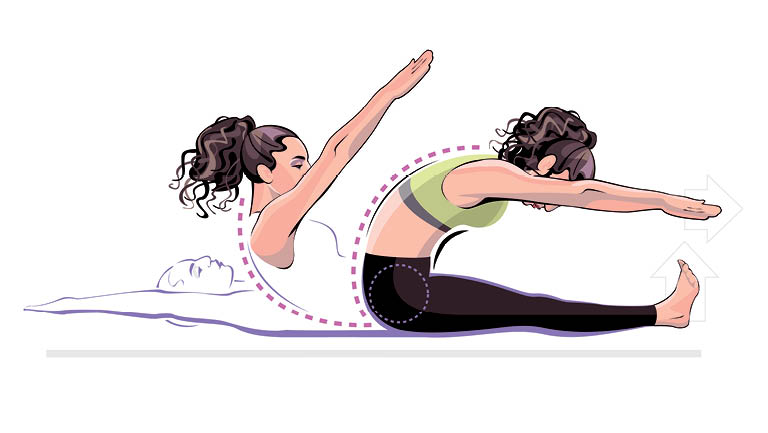
Repeat for five reps.
Full Instructions
- Lie on your back with your legs together and extended, your feet flexed, and your arms reaching overhead.
- Contract your abdominals and imagine connecting your front to your back, and your back to the mat.
- Keeping your legs and arms straight, slowly roll up your spine, head first, until you are sitting up. Fold forward, keeping your core engaged and creating a C-shape with your spine and reaching your arms forward, toward your feet.
- Slowly roll backward onto the floor, laying your spine on the floor one vertebra at a time.
- Repeat for five reps.
Coordination
Connects breath to movement, and lower body to upper body.

Repeat for six reps.
Full Instructions
- Lie on your back, arms by your sides, and raise your legs off the floor, toes pointed, creating a 90-degree angle between your back and your thighs, and between your thighs and your calves.
- Raise your head off the floor and bend your elbows, raising your forearms off the floor, wrists straight, palms facing away from you. This is your starting position.
- Inhale deeply through your nose as you lower your forearms to the floor, palms down.
- Hold your breath as you extend your legs outward, about 45 degrees to the floor. From this position, separate your legs as much as possible, then bring them back together.
- Exhale as you return your legs, and then your arms, to the starting position.
- Repeat for six reps.
Variation for cyclists: After extending your legs outward, bicycle your legs twice slowly forward, and then twice slowly backward, before returning to the starting position (not shown).
Swimming
Lengthens your body, working the extensor muscles of your back.

Repeat for five to 10 reps. This is a challenging move — pace yourself and focus on quality of movement rather than speed or reps.
Full Instructions
- Lie on your stomach, arms extended overhead, legs spread comfortably.
- Simultaneously lengthen your arms and extend your legs as much as possible, as if trying to elongate your entire body along the floor.
- Contract your abdominals, connecting your front body with your back body, and raise your arms, head, and legs off the floor. Work on creating length from fingertips to toes as you lift, and avoid straining your back by overarching. Think about your hands and feet reaching to opposite walls rather than reaching for the ceiling.
- Keeping your arms and legs extended, begin to slowly flutter them.
- As you pulse your arms and legs up and down, inhale through your nose on a five-count of pulses, counting each time an arm goes down, then exhale through your nose on another slow five-count. That’s one rep.
- Repeat for five to 10 reps. This is a challenging move — pace yourself and focus on quality of movement rather than speed or reps.
Make it easier: Build stamina and coordination by moving the arms and legs only, without raising your head and torso off the floor. Perform a few reps of cat–cow when you’re done to stretch and extend your back muscles. (Learn how at “BREAK IT DOWN: The Cat-Cow“.)
Thigh Stretch
Actively stretches your quadriceps (front thighs) and hip flexors.
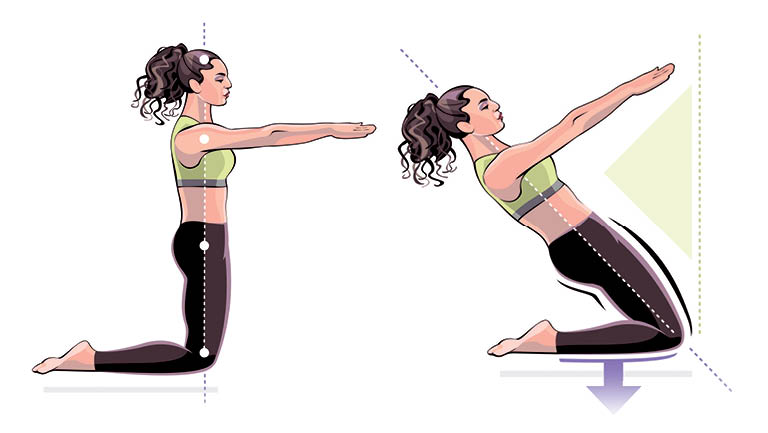
Perform five reps.
Full Instructions
- Start in a tall-kneeling position with your pelvis directly over your knees and your shoulders and head directly over your pelvis. Position your knees and feet about two fists’ distance apart.
- Gaze forward and extend your arms forward, palms down.
- Maintaining a straight line between your knees and the crown of your head, inhale through your nose as you slowly lean your body backward, pushing the floor away with your lower legs.
- Rock back as far as you can while maintaining postural alignment, then return to the starting position.
- Exhale slowly, then repeat for five reps.
This article originally appeared as “Firm Foundation” in the May 2021 issue of Experience Life.
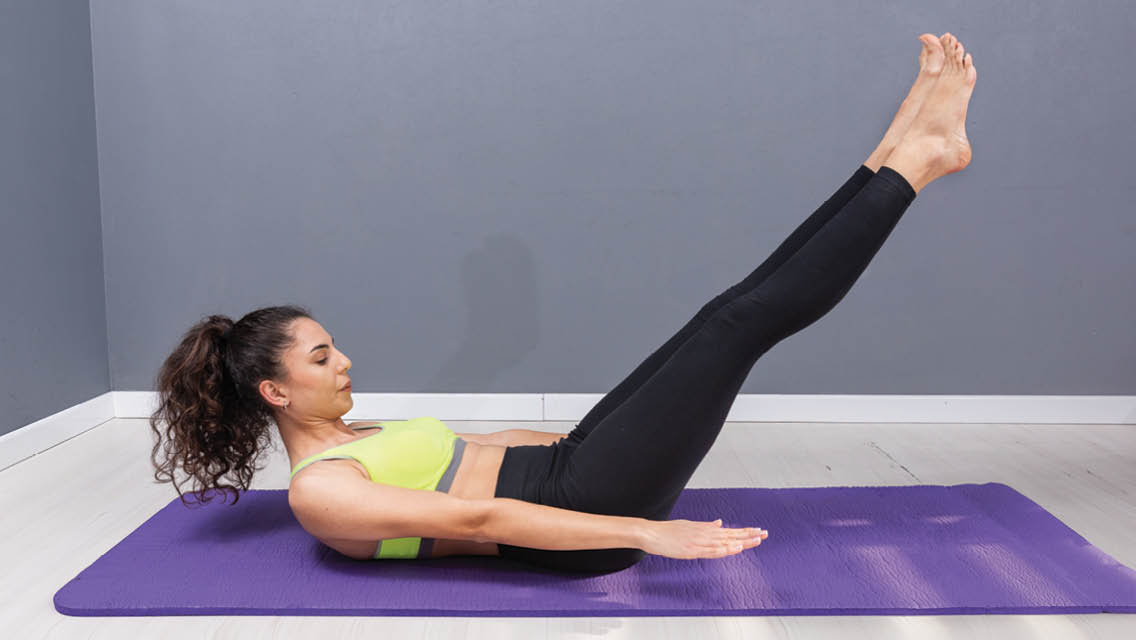



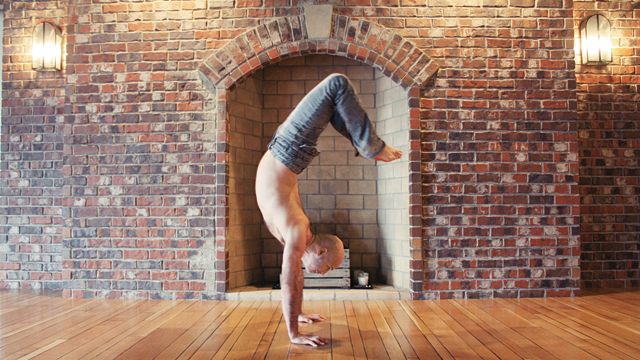
This Post Has 0 Comments